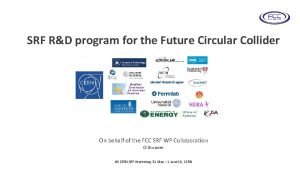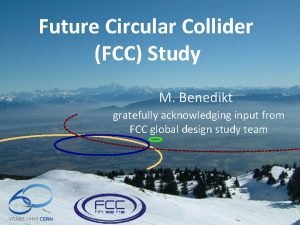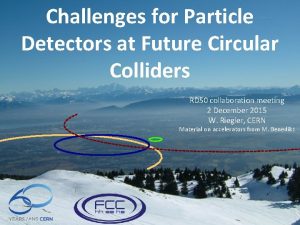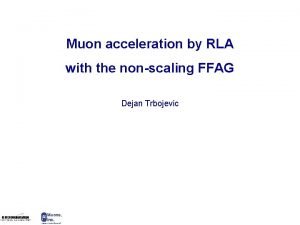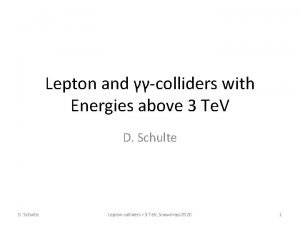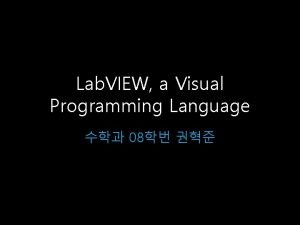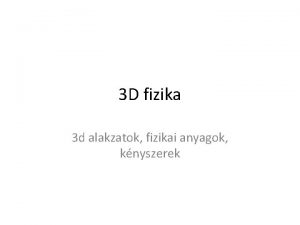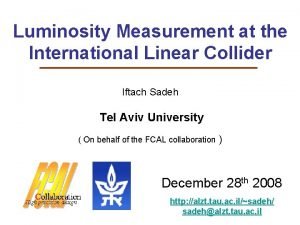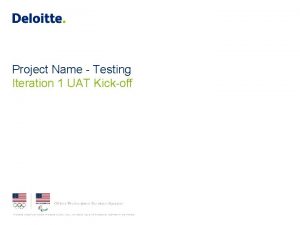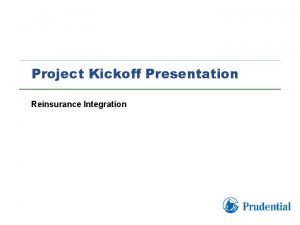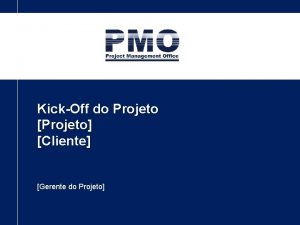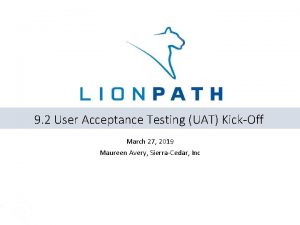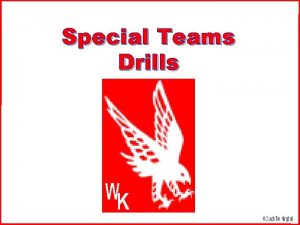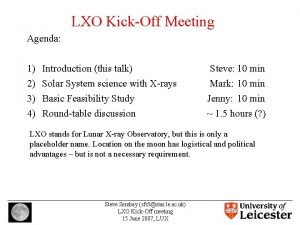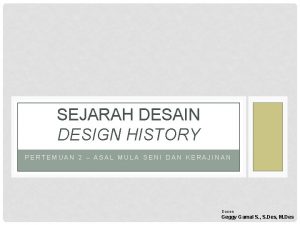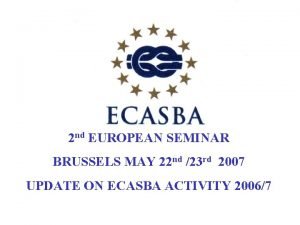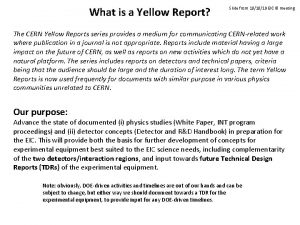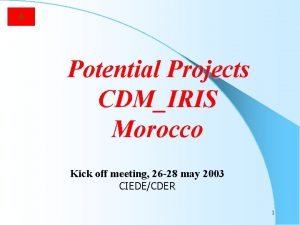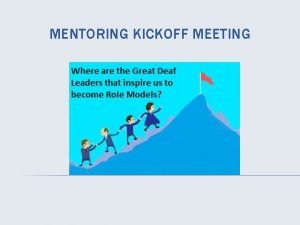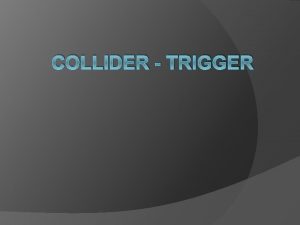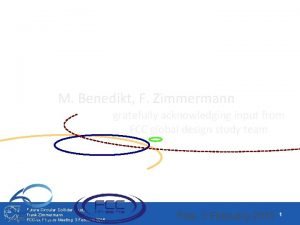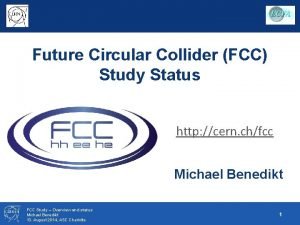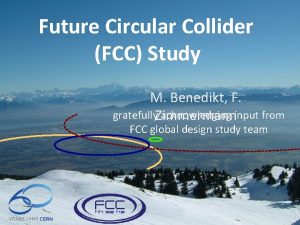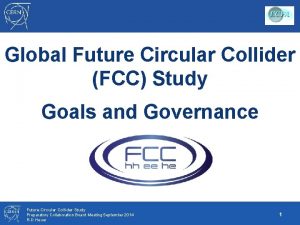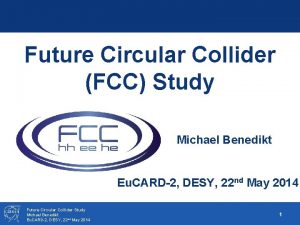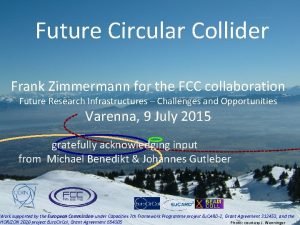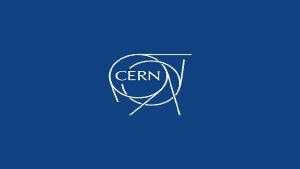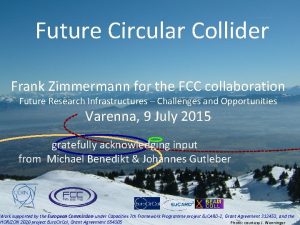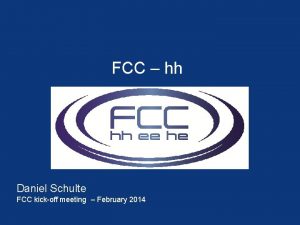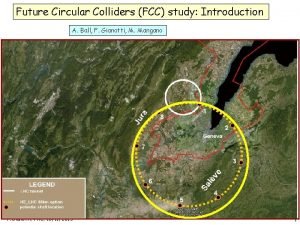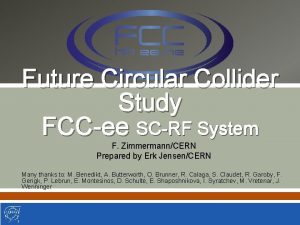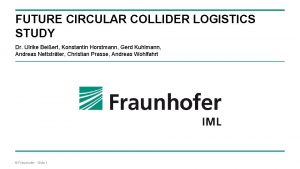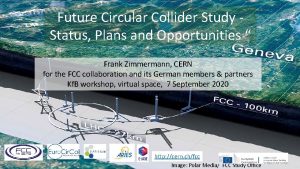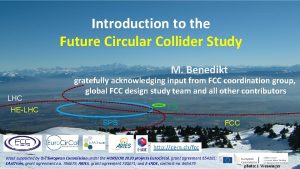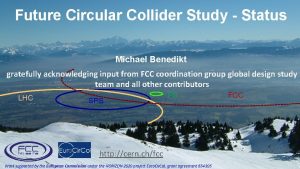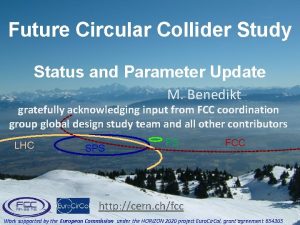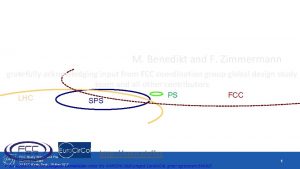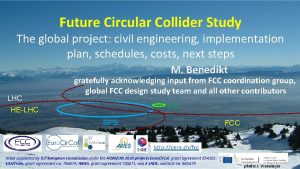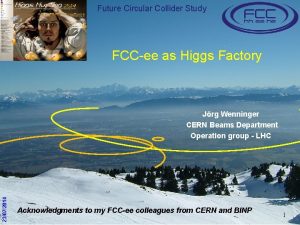FCC KickOff 2014 Future Circular Collider FCC Study

























- Slides: 25

FCC Kick-Off 2014 Future Circular Collider (FCC) Study Michael Benedikt, Frank Zimmermann Future Circular Collider Study Michael Benedikt FCC Kick-Off 2014 1

Outline • Motivation & scope • Parameters & design challenges • Preparing global FCC collaboration • Study organization – WBS • Study Time Line, next steps • EU FCC design study proposal • Summary Future Circular Collider Study Michael Benedikt FCC Kick-Off 2014 2

Summary: European Strategy Update 2013 Design studies and R&D at the energy frontier …. “to propose an ambitious post-LHC accelerator project at CERN by the time of the next Strategy update”: d) CERN should undertake design studies for accelerator projects in a global context, • with emphasis on proton-proton and electron-positron high-energy frontier machines. • These design studies should be coupled to a vigorous accelerator R&D programme, including high-field magnets and high-gradient accelerating structures, • in collaboration with national institutes, laboratories and universities worldwide. • http: //cds. cern. ch/record/1567258/files/esc-e-106. pdf Future Circular Collider Study Michael Benedikt FCC Kick-Off 2014 3

CLIC CDR and cost study (2012) • 3 volumes CDR: physics & detectors, accelerator complex, strategy, cost & schedule • Collaborative effort: 40+ institutes worldwide Future Circular Collider Study Michael Benedikt FCC Kick-Off 2014 4

Future Circular Collider Study - SCOPE CDR and cost review for the next ESU (2018) Forming an international collaboration to study: • pp-collider (FCC-hh) defining infrastructure requirements ~16 T 100 Te. V pp in 100 km ~20 T 100 Te. V pp in 80 km • e+e- collider (FCC-ee) as potential intermediate step • p-e (FCC-he) option • 80 -100 km infrastructure in Geneva area Future Circular Collider Study Michael Benedikt FCC Kick-Off 2014

FCC motivation: pushing energy frontier High-energy hadron collider FCC-hh as long-term goal • Seems only approach to get to 100 Te. V range in the coming decades • High energy and luminosity at affordable power consumption • Lead time design & construction > 20 years (LHC study started 1983!) Must start studying now to be ready for 2035/2040 Lepton collider FCC-ee as potential intermediate step • Would provide/share part of infrastructure • Important precision measurements indicating the energy scale at which new physics is expected • Search for new physics in rare decays of Z, W, H, t and rare processes Lepton-hadron collider FCC-he as option • High precision deep inelastic scattering and Higgs physics Most aspects of collider designs and R&D non-site specific. Tunnel and site study in Geneva area as ESU requests. Future Circular Collider Study Michael Benedikt FCC Kick-Off 2014 6

Main areas of FCC design study Accelerators and infrastructure conceptual designs Technologies R&D activities planning Physics experiments detectors Hadron collider conceptual design High-field magnets Lepton collider conceptual design Superconducting RF systems Hadron coll. physics experiments interface, integration Hadron and lepton injectors Cryogenics Safety, operation, energy management environmental aspects Specific technologies Infrastructure Planning Future Circular Collider Study Michael Benedikt FCC Kick-Off 2014 e+ e- coll. physics experiments interface, integration e- - p physics, experiments, Interface, integration

FCC-hh parameters – starting point Energy Dipole field Circumference #IPs Luminosity/IPmain Stored beam energy Synchrotron radiation Long. emit damping time Bunch spacing Bunch population (25 ns) Transverse emittance #bunches Beam-beam tune shift b* Future Circular Collider Study Michael Benedikt FCC Kick-Off 2014 100 Te. V c. m. ~ 16 T (Nb 3 Sn), [20 T option HTS] ~ 100 km 2 main (tune shift) + 2 5 x 1034 cm-2 s-1 8. 2 GJ/beam 26 W/m/aperture (filling fact. ~78% in arc) 0. 5 h 25 ns [5 ns option] already available 1 x 1011 p from SPS for 25 ns 2. 2 micron normalized 10500 0. 01 (total) 1. 1 m (HL-LHC: 0. 15 m) 8

FCC-hh design challenges Optics and beam dynamics • IR design, dynamic aperture studies, SC magnet field quality Impedances, instabilities, feedbacks • Beam-beam, e-cloud, resistive wall, feedback systems design Synchrotron radiation damping • controlled blow up, luminosity levelling, etc… Energy in beam & magnets dump, collimation, quench protection • Stored beam energy critical: 8 GJ/beam (0. 4 GJ LHC) • Beam losses, radiation effects collimation, shielding • Synergies intensity frontier (SNS, J-PARC, PSI, PIP, FRIB, ESS, FAIR) High synchrotron radiation load on beam pipe • Up to 26 W/m/aperture in arcs, total of ~5 MW for FCC-hh • (LHC has a total of 1 W/m/aperture from different sources) • Heat extraction: photon stop, beam screen temperature, cryo load, • Synergies with SSC, VLHC, light sources, Spp. C, … Future Circular Collider Study Michael Benedikt FCC Kick-Off 2014 9

High-field magnet R&D targets FCC-hh baseline 16 T Nb 3 Sn technology for ~100 Te. V c. m. in ~100 km Develop Nb 3 Sn-based 16 T dipole technology, • with sufficient aperture (~40 mm) and • accelerator features (field quality, protectability, cycled operation). • In parallel conductor developments Possible goal: • 16 T short dipole models by 2018 (America, Asia, Europe) In parallel HTS development targeting 20 T: • HTS insert, generating O(5 T) additional field • in large aperture O(100 mm, 15 T) Possible goal: demonstrate HTS/LTS 20 T technology in two steps • a field record attempt to break the 20 T barrier (no aperture), and • a 5 T insert, with sufficient aperture (40 mm) and accel. features Future Circular Collider Study Michael Benedikt FCC Kick-Off 2014 10

FCC-ee parameters – starting point Design choice: max. synchrotron radiation power set to 50 MW/beam • Defines the maximum beam current at each energy • 4 physics operation points (energies) foreseen Z, WW, H, ttbar • Optimization at each operation point, mainly via bunch number and arc cell length Parameter Z WW H ttbar LEP 2 E/beam (Ge. V) 45 80 120 175 105 28. 0 12. 0 5. 9 1. 8 0. 012 Bunches/beam 16700 4490 1330 98 4 I (m. A) 1450 152 30 6. 6 3 Bunch popul. [1011] 1. 8 0. 7 0. 47 1. 40 4. 2 Cell length [m] 300 100 50 50 79 Tune shift / IP 0. 03 0. 06 0. 09 0. 07 L (1034 cm-2 s-1)/IP Future Circular Collider Study Michael Benedikt FCC Kick-Off 2014 11

FCC-ee design challenges Short beam lifetime from high luminosity (radiative Bhabha scattering) • Top-up injection (single injector booster in collider tunnel) Additional lifetime limit from beamstrahlung at top operation energy • • Flat beams (small vertical emittance, small vertical b* ~ 1 mm) Final focus with large (~2%) energy acceptance to reduce losses Machine layout for high currents, large #bunches at Z pole, WW, H • Two ring layout and configuration of the RF system. Polarization for high precision energy calibration at Z pole and WW with long natural polarization times (WW: ~10 hours, Z: ~200 hours) Important expertise available worldwide and potential synergies: • IR design, experimental insertions, machine detector interface, (transverse) polarization RHIC, VEPP-2000, BEPC-II, SLC, LEP, B- and Super-B factories, CEPC, ILC, CLIC Future Circular Collider Study Michael Benedikt FCC Kick-Off 2014 12

SC-RF main R&D areas Future Circular Collider Study Michael Benedikt FCC Kick-Off 2014 13

FCC-he parameters – starting point • Design choice: beam parameters as available from hh and ee • Max. e± beam current at each energy determined by 50 MW SR limit. • 1 physics interaction point, optimization at each energy collider parameters species e± scenarios protons e± (polarized) e± e± p beam energy [Ge. V] 80 120 175 50000 luminosity [1034 cm-2 s-1] 2. 3 1. 2 0. 15 bunch intensity [1011] 0. 7 0. 46 1. 4 1. 0 #bunches per beam 4490 1360 98 10600 beam current [m. A] 152 30 6. 6 500 sx, y* [micron] Future Circular Collider Study Michael Benedikt FCC Kick-Off 2014 4. 5, 2. 3 14

FCC-he design challenges Integration aspects, machine detector interface • Synchrotron radiation • Large polar angle acceptance IR optics & magnets with 3 beams • Crossing scheme • Detector integrated dipole, final SC quadrupoles, crab cavities, Concurrent operation of e±h with hh or/and e+e- operation? Relevant expertise available worldwide and potential synergies: Û HERA, e. RHIC, MEIC, HIAF-EIC, … Alternative option for eh collisions in connection with FCC-hh: • Potential reuse of an energy recovery linac (ERL) that is being studied in the frame of the LHe. C study. Future Circular Collider Study Michael Benedikt FCC Kick-Off 2014 15

FCC global design study preparation Following ESU in May 2013, creation of a small preparation group in autumn 2013 to prepare on a short time scale: • • • preliminary draft baseline parameter sets for all options a possible work breakdown structure and study organisation an international kick-off meeting (now!) Kick-off event should start process of internat. collaboration • presenting preparatory work as basis for discussion draft parameter sets & WBS documents available • inviting feedback and suggestions • working towards formation of a global design study collaboration integrating all aspects of machines, physics and detectors Reflected in kick-off meeting programme. Future Circular Collider Study Michael Benedikt FCC Kick-Off 2014 16

International collaboration process in 2014 Proposal for next steps: • • • Suggestions and comments from international community and discussion on study contents, organisation and resources Invitation of non-committing expressions of interest for contributions from worldwide institutes by end May 2014 Prepare formation of International Collaboration Board (ICB); proposed date first meeting 9 -11 September 2014, to start FCC study expressions of interest (EOI) kick-off event discussions iterations March April May June July proposed 1 st ICB meeting August September 2014 Process can be moderated by preparation group (possibly extended – following EOI) until global collaboration is formed an international team is put in place to conduct the further study Process remains open, further joining possible … Future Circular Collider Study Michael Benedikt FCC Kick-Off 2014 17

FCC Kick-Off & Study Preparation Team Future Circular Colliders - Conceptual Design Study coordination, M. Benedikt, F. Zimmermann Hadron collider D. Schulte Hadron injectors B. Goddard e+ e- collider Infrastructure, and injectors cost estimates J. Wenninger P. Lebrun e- p option Integration aspects O. Brüning Operation aspects, energy efficiency, safety, environment P. Collier Technology High Field Magnets L. Bottura Superconducting RF E. Jensen Cryogenics L. Tavian Specific Technologies JM. Jimenez Physics and experiments Hadrons A. Ball, F. Gianotti, M. Mangano e+ e. A. Blondel J. Ellis, P. Janot e- p M. Klein Planning (Implementation roadmap, financial planning, reporting) F. Sonnemann, J. Gutleber Future Circular Collider Study Michael Benedikt FCC Kick-Off 2014 18

Proposal for FCC WBS top level preliminary Future Circular Collider Study Michael Benedikt FCC Kick-Off 2014 19

WBS – lower level example: FCC-ee study Draft work packages and units International contributors and convenors needed for technical areas and study organisation Future Circular Collider Study Michael Benedikt FCC Kick-Off 2014 20

Proposed international organization structure CERN DG Collaboratio n Board Steering Committee 1 person/inst. Advisory Committee 2 -3 persons/region 1 -2 experts/field FCC Study Coordination Hadron Collider Physics Experiments Lepton Collider Physics Experiments e-p Physics Experiments Accelerators Future Circular Collider Study Michael Benedikt FCC Kick-Off 2014 Hadron Injectors Hadron Collider Lepton Injectors Lepton Collider Accelerator R&D Technologies Infrastructures Operation Costing Planning 21

Proposal for FCC Study Time Line 2014 Q 1 Q 2 Q 3 2015 Q 4 Q 1 Q 2 Q 3 2016 Q 4 Q 1 Kick-off, collaboration Prepar forming, e study plan and organisation Ph 1: Explore options “weak interaction” Q 2 2017 Q 3 Q 4 Q 1 Q 2 Q 3 2018 Q 4 Q 1 Q 2 Q 3 Workshop & Review identification of baseline Ph 2: Conceptual study of baseline “strong interact. ” Workshop & Review, cost 4 large FCC Workshops distributed over participating regions Future Circular Collider Study Michael Benedikt FCC Kick-Off 2014 model, LHC results study rescoping? Ph 3: Study consolidation Workshop & Review contents of CDR Report Release CDR & Workshop on next steps 22 Q 4

Possible FCC Study Phases Phase 1: Explore options, now – spring 2015: - Investigate different options in all technical areas, taking a broad view Deliverables: description and comparison of options with relative merits/cost FCC workshop to converge to common baseline with small number of options Proposed WS date 23 – 27 March 2015 (presently no known collisions…) Followed by review ~2 months later, begin June 2015 Phase 2: Conceptual design: spring 2015 – autumn 2016 - Conceptual study of baseline and remaining options with iterations between all areas - Deliverable: description of baseline with first cost model, identification of critical areas, cost drivers, performance limitations - FCC workshop to discuss conceptual design, performance and cost figures - Proposed date autumn 2016. - Followed by review 2 months later to take into account LHC results and do re-scoping of study for phase 3 Phase 3: Study consolidation: winter 2016 – winter 2017 - Detailed conceptual design of re-scoped baseline - Deliverables: description of re-scoped baseline with cost model, identification of critical areas, cost drivers, performance limitations, planning for further R&D activities - FCC workshop to discuss conceptual design, performance and cost figures and contents for CDR editing. - Proposed date autumn 2017. - Followed by review 2 months later to confirm CDR contents Phase 4: Editing conceptual design report: winter 2017 – summer 2018 Future Circular Collider Study Michael Benedikt FCC Kick-Off 2014 23

FCC EU Design Study (DS) Proposal Horizon 2020 call – design study, deadline 02. 09. 2014 Prepare proposal parallel to FCC collaboration setup Goals fo EU DS: conceptual design, prototypes, cost estimates, … From FP 7 Hi. Lumi LHC DS positive experience: • 5 -6 work packages as sub-set of FCC study • ~10 -15 beneficiaries (signatories of the contract with EC) input from interested kick-off partners, event discussions end of May Time line March April May complete submission iteration, draft of EU FCC DS agreements, proposal, 2 Sept. end of June signatures June July August September 2014 Non-EU partners can join as beneficiary – signatory with or w/o EC contribution (contractual commitment) or as associated partner – nonsignatory (in-kind contribution with own funding, no contractual commitment) Future Circular Collider Study Michael Benedikt FCC Kick-Off 2014

FCC Study - Summary • In line with the European Strategy, CERN is launching a 5 -year international design study for Future Circular Colliders; • Worldwide collaboration in all areas - physics, experiments and accelerators – is essential to reach CDR level by 2018. • FCC R&D areas e. g. SC high-field magnets and SC RF are of general interest & relevant for many other applications. • Significant R&D investments have been made over last decade(s), e. g. in the framework of LHC and HL-LHC; further continuation will ensure efficient use of past investments. • Goals of kick-off meeting: Introducing FCC study, discussing study scope and organization, preparing and establishing collaboration! Invitation to join! Future Circular Collider Study Michael Benedikt FCC Kick-Off 2014 25
 Cern future circular collider
Cern future circular collider Fcc collider
Fcc collider Fcc collider
Fcc collider Future continuous and future perfect examples
Future continuous and future perfect examples Future simple continuous perfect
Future simple continuous perfect Muon collider
Muon collider Muon collider
Muon collider Particle collider
Particle collider Unity sphere collider
Unity sphere collider Hadron collider
Hadron collider Hadron collider
Hadron collider International linear collider
International linear collider 5 elements of hair
5 elements of hair Today meeting or today's meeting
Today meeting or today's meeting Uat kick off meeting
Uat kick off meeting Project kickoff meeting presentation
Project kickoff meeting presentation Mentor meeting agenda
Mentor meeting agenda Kickoff projeto
Kickoff projeto Uat kickoff meeting agenda
Uat kickoff meeting agenda Special teams drills
Special teams drills Proposal kickoff meeting agenda
Proposal kickoff meeting agenda Desain kerajinan
Desain kerajinan Fast kickoff training code
Fast kickoff training code Yellow report eic
Yellow report eic Kickoff projet
Kickoff projet Circle k #45067
Circle k #45067
